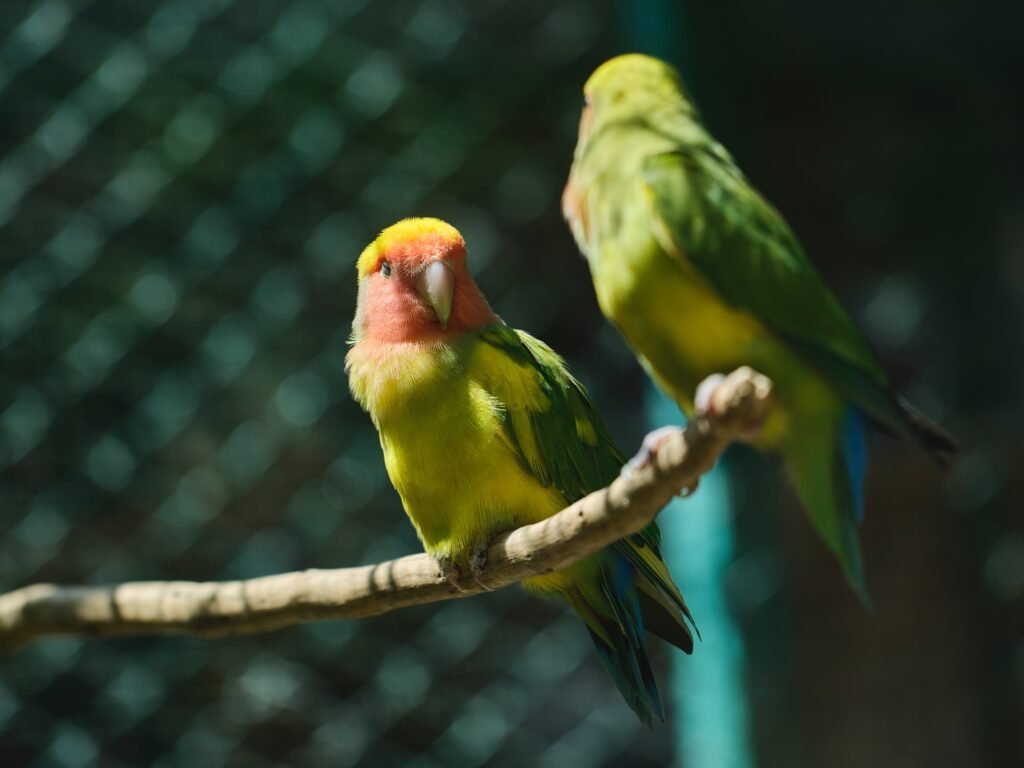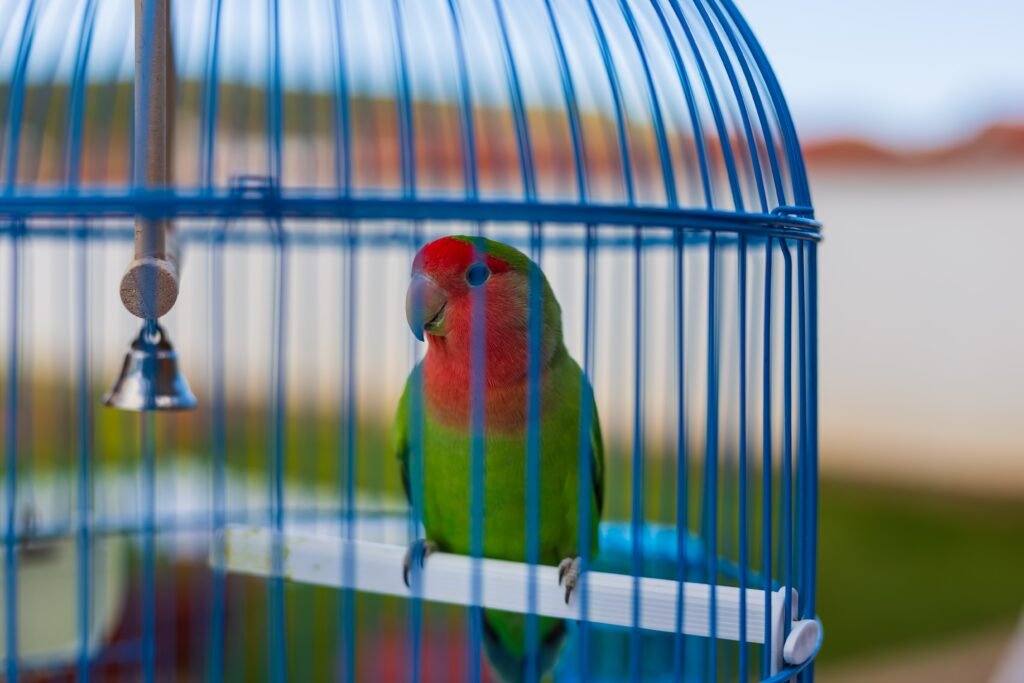Lovebirds make for wonderful companions with their vibrant colours and affectionate nature. However, like any pet, they require proper training to ensure they become well-behaved and happy members of your household. This article will explore tips and techniques to effectively train your lovebird and strengthen your bond with them.
Understanding Lovebirds
Before diving into the training process, it’s essential to understand the basic characteristics of lovebirds. Lovebirds are social creatures that thrive on companionship and interaction. They are highly intelligent and can learn many behaviours and tricks with patience and consistent training.
Lovebirds are known for their ability to form strong bonds with their owners, and they require plenty of socialization to thrive. By introducing your lovebird to different people, sounds, and environments early on, you can help them become confident and friendly. Gradually expose them to various stimuli, considering their comfort levels, to prevent fear or aggression. This socialization process will enhance their overall well-being and make training easier as they become more receptive to learning.
Creating a Positive Environment
Lovebirds respond best to positive reinforcement techniques. Creating a supportive and enriching environment is crucial for their development. Here are some essential steps to set up a positive training environment for your lovebird:
- Cage Setup: Ensure your lovebird has a spacious cage with enough room for movement and exercise. Lovebirds are active creatures and need space to stretch their wings and engage in natural behaviours. Provide perches of varying sizes and textures to keep their feet healthy and toys that encourage mental stimulation and physical activity. Rotate the toys regularly to prevent boredom.
- Location: Choose a calm and quiet area for the lovebird’s cage, away from excessive noise, direct sunlight, and drafts. Lovebirds are sensitive to their environment; a peaceful setting will help them focus during training sessions. Avoid placing their cage in busy areas of your home, such as the kitchen or living room, as constant activity can be stressful for them.
- Consistency: Establish a consistent routine for feeding, handling, and training. Lovebirds thrive on predictability, so sticking to a schedule will make them feel secure and aid their training progress. Set fixed times for training sessions and ensure that everyone in the household follows the same rules and commands. Consistency will reinforce their understanding of what is expected from them and facilitate faster learning.
Providing a positive environment goes beyond the physical setup. Interact with your lovebird regularly, offering them attention, praise, and treats for good behaviour. This positive reinforcement will motivate them to repeat desirable actions and strengthen the bond between you and your feathered companion.
Basic Training Techniques
Now that you’ve set up an ideal environment for training, let’s dive into some basic techniques to teach your lovebird good behaviour:
- Socialization
Socialization plays a crucial role in shaping your lovebird’s behaviour and temperament. By exposing them to different people, sounds, and environments, you can help them become well-adjusted and confident companions. Gradually introduce them to new experiences, ensuring they feel safe and comfortable. This could include inviting friends or family members to interact with your lovebird, playing calming background sounds, or taking them for short outings in a secure travel cage. Exposing them to various stimuli reduces the likelihood of fear or aggression in unfamiliar situations.
- Target Training
Target training is a valuable technique that enables you to teach your lovebird basic commands and tricks using positive reinforcement. Follow these steps to start target training:
- Hold a small stick or your finger out towards the lovebird.
- When they touch the stick or your finger with their beak, praise them and offer a treat.
- Repeat this process multiple times until they consistently touch the target.
- Gradually, start moving the target stick to different positions, encouraging them to follow it.
Target training not only helps in teaching specific commands but also improves your lovebird’s focus and coordination. It is a versatile technique that can teach a wide range of behaviours, such as stepping onto your hand, turning in a circle, or even retrieving small objects. Be patient and consistent, and always reward your lovebirds for their efforts.
- Step-Up Command
The step-up command is an essential behaviour that allows your lovebird to step onto your finger or hand when asked. Follow these steps for successful step-up training:
- Gently place your hand close to your lovebird’s chest.
- Say “step up” in a clear and encouraging tone.
- Reward them with praise and a treat when they voluntarily step onto your hand.
- Repeat this process regularly until they respond to the command consistently.
The step-up command is useful for handling and transportation purposes and strengthens the bond between you and your lovebird. It establishes trust and teaches your lovebird to willingly interact with you. Practice this command regularly and make it a positive experience, using treats and verbal praise as rewards.
- Recall Training
Recall training ensures your lovebird returns to you on command, promoting safety and a strong bond. To train your lovebird to come to you when called, follow these steps:
- Choose a specific word or phrase as the recall cue, such as “come” or “here, [bird’s name].”
- Say the recall cue while gently tapping your fingers against your chest.
- When your lovebird flies or walks to you, reward them with praise and a treat.
- Practice recall training in different areas of your home to reinforce the behaviour.
Recall training is a vital skill that allows you to call your lovebird back to safety if they accidentally escape or get into a potentially dangerous situation. By incorporating recall training into your routine, you can ensure that your lovebird remains connected to you and can enjoy supervised time outside of their cage.
Advanced Training Techniques
Once your lovebird has mastered the basic training techniques, you can move on to more advanced behaviours and tricks. Here are a few ideas to enhance their training further:
- Wave: Teach your lovebird to wave by extending your hand towards them and saying “wave” as they lift their foot to touch your finger. Reward and praise them for acting. With consistent practice, your lovebird will learn to associate the hand gesture with the verbal cue and perform the wave on command.
- Ring Toss: Introduce a small plastic ring and teach your lovebird to pick it up with their beak and place it on a peg. Start by rewarding them for touching the ring, then progress to rewarding them for picking it up and placing it on the peg. Break down the task into small steps, and be patient as your lovebird learns each component.
- Basketball: Attach a small basketball hoop to their cage and encourage them to pick up a small ball and shoot it through it. Start by rewarding them for touching the ball, picking it up, and successfully shooting it through the hoop. This advanced trick requires coordination and focus, so be patient and provide plenty of positive reinforcement.
- Talking: Lovebirds can mimic human speech, and with time and practice, they can learn to imitate specific words or phrases. Spend quality time talking to your bird, repeating words or phrases you’d like them to learn. Use a clear and consistent tone, and be patient as they attempt to mimic your speech. Eventually, they may start imitating those words, adding a unique touch to their repertoire of behaviours.
Patience, consistency, and positive reinforcement are the keys to successful lovebird training. Always provide treats, verbal praise, and physical affection to reinforce good behaviour. With time and effort, you will develop a strong bond with your lovebird and enjoy the rewards of a well-behaved and affectionate companion.
Lovebirds Training: Tips and Techniques for a Well-Behaved Companion – FAQ
Q: What are some basic characteristics of lovebirds? A: Lovebirds are social creatures that thrive on companionship and interaction. They are highly intelligent and can learn many behaviours and tricks with patience and consistent training.
Q: How can I create a positive environment for my lovebird? A: To create a positive environment, ensure your lovebird has a spacious cage with enough room for movement and exercise. Choose a calm and quiet location for their cage, and establish a consistent feeding, handling, and training routine. Interact with your lovebird regularly, offering them attention, praise, and treats for good behaviour.
Q: What is target training, and how can I use it to train my lovebird? A: Target training is a technique that enables you to teach your lovebird basic commands and tricks using positive reinforcement. It involves using a small stick or finger as a target for your lovebird to touch with their beak. By praising and offering treats when they touch the target, you can teach them specific behaviours and improve their focus and coordination.
Q: How can I train my lovebird to come to me on command? A: Use recall training to train your lovebird to come to you when called. Choose a specific word or phrase as the recall cue, such as “come” or “here, [bird’s name].” Say the recall cue while gently tapping your fingers against your chest. When your lovebird flies or walks to you, reward them with praise and a treat. Practice recall training in different areas of your home to reinforce the behaviour.


